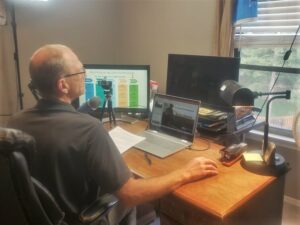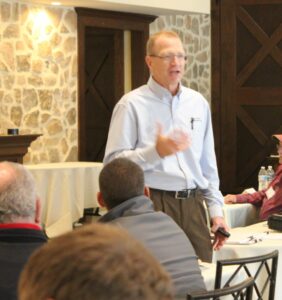The problem with most sales training!
Forty-five minutes into day one and I was already regretting my choice of seats. The morning started off great, several managers and top sales people gathered to attend a first round training session for our new sales training program. Feeling proud to be a part of this group, you can imagine the excitement as we started into our opening session. We had pads of sticky notes, colored markers and flip charts in all corners of the room as introductions began. Following introductions, we participated in the ice breaker (two truths and a lie). Fun times were being had by all.
Pleasantries and intros over with, we started in on the heart of why we were there – sales training. Not the technical side of the business as this was a mix of people from different product lines. This was going to be two full days of “soft” skills. I don’t necessarily agree with the term soft as they can be some of the toughest skills to learn. Either way, we were excited when Steve (our facilitator) started handing out our DISC profiles. Soon, everyone was chattering as to the validity of the assessment and how accurately it depicted their personality. The chatter instantly ceased as Steve said he had some gifts for us. Nothing gets a room of sales people more focused than free promo items. We always want to see what other companies are giving away and see how props can help explain the sales process. In reality, we just like toys. They’re fun, free and we can give them to our kids as travel gifts from abroad.
Steve presented each one of us with our very own Slinky. We tore into them like it was Christmas morning and immediately began “slinkying”. Back and forth, back and forth we slinkyed. We had absolutely no idea why we were given a Slinky, but we had them and we were enjoying them. By 15 minutes, most of us had quit slinkying. By 20 minutes, all but one of us had stopped. Not Carlton though. He just kept on a slinkying, over and over and over, right next to me. I caught the glance of friends across the room as they were signaling me to tear the slinky away from Carlton and twist it into knots. I was regretting my choice of seats next to Carlton, when Steve baled me out. He asked the group to put down our Slinky’s and jump into a breakout session.
So, what was the purpose of the slinky to begin with? Steve explained the concentric rings of the slinky depict the cycle of going through the sales process over and over again with our customers. Now, most sales training teaches you a process to go through. It’s usually a sequence of connecting, discovering, sharing, closing and then follow up. While that’s certainly a proven methodology of the order of selling, we have one problem in Ag sales. That problem is that Ag sales are long term relationships. That means the selling cycle can also be a long-term process. Why is that a problem? Because after we run through our first cycle (connect-discover-present-close), what do we all expect to happen? A SALE! But, that doesn’t happen. Why? Lots of reasons. You didn’t create enough value, your price was too high, they don’t need your product or service…. the list goes on. However, one of the first reasons they don’t buy is trust. They don’t know you or your company. You popped onto the scene and laid everything out there on the kitchen table as to how you can save them money. Great. Now they need to figure out whether they can trust you. They are currently doing business with someone else and probably feel like it’s working. Why change? They know their current product and salesperson. It’s comfortable, safe. You are asking them to change.
It’s important to understand the impact of asking someone to change. Especially, a person who most likely lives in the same place, does the same job and probably drives the same brand of equipment his entire life. It may take several sales calls before they are comfortable turning their business over to you. This is both good and bad. The good part is that the customer doesn’t jump ship on his suppliers every time someone drives down the driveway. With plenty of competition, it’s always good to enjoy customer loyalty that you hopefully earn every day. The bad part is that it’s going to take time and follow up. However, you’re in a hurry to conquer the territory. I get it. You followed the process. You connected, you asked a few questions, then presented your products and asked for the sale. “What’s not to love?” Yet he didn’t buy! What now? We’ll help with that in a minute.
Back to Carlton and his incessant slinkying. The whole premise of the slinky is that the process is repeated over and over with a customer. You have to get the Follow Up appointment to continue the process. The problem with this training was the same problem most sales training has: we didn’t train on follow up skills. The fun and exciting part of training is Discovery (asking questions) and Closing skills. Those are very important and need to be trained. However, facilitators spend so much time on them, they run out of time to train on Follow Up skills. It’s not intentional. Discovery and Closing Skills just take time and attendees usually need a lot of help with them. The class is engaged and that is thrilling for a facilitator. Who wants to kill the mood of an engaged audience by talking about how to get back on the farm for the 2nd, 3rd, 10th, 15th or 20th time?
So, at the end of two long days of intense sales training, with Carlton’s Slinky finally quieted down, Steve asked us, “Well folks, we are running late and we have one section left. The Follow Up. It closes the loop and makes it a circle.” “Should we cover it or do you feel comfortable with your ability to follow up?” Guess what we chose! “We’re good. We got it. No need to cover it.”
And we didn’t. Steve cut us loose and we streamed out of training with our cell phones stuck in our ears and 200 emails to go through. We were ready to go out and conquer our territories with rejuvenated energy in Connecting, Discovering, Presenting and Closing. Having never talked about how to get back on the farm in front of our prospect.
Key points in Follow Up skills:
– It’s a necessary process of building trust. Make promises and keep them. Do what you say you will do
– The ability to get a follow-up appointment comes from the information you uncover early in the conversation. The follow-up request happens at the end, but it comes from information you gather at the beginning.
– Persistence isn’t pushy or salesy. Persistence with nothing new to add can be though.
– Being constantly curious will uncover ways you can help, which produces follow up appointments. Digging in and uncovering information allows you to come back sooner. Remember back when you were in a hurry to conquer your territory and wanted to speed things up with a prospect? Digging in and doing the detail work of asking good questions slashes the time needed between calls on a prospect.
– Just ask! Let’s say you are on your second sales call with a prospect. It’s going nowhere. You haven’t found any needs that your products can fill. You’re struggling to figure out a reason to come back out for a follow-up appointment. The conversation is dying quickly and you can tell it’s time to go. Timing is critical. Before he says, “Well, I better get going. Thanks for stopping out.” Just ask. “When would be a good time for me to follow up with you?” Hopefully, he has an interest in something you said. If not, then ask when will he make a decision on what you are selling. Then, ask to come see him just prior to the decision.
Epilogue: Carlton’s slinky mysteriously disappeared before day two started. It was last seen wrapped around a semi bumper heading West on I-80. I think lives were threatened if anyone was to give him another one.
Make your next meeting memorable by bringing in a speaker who’s been there.
Contact me to find out how Greg@GregMartinelli.net (608) 751-6971
For more Ag Sales Training, Ag Sales Coaching and Leading Ag Sales Teams, go to http://www.GregMartinelli.net/
Webinar
Want to learn more about Closing the Sale on your next farm call?
Click on the link below!





